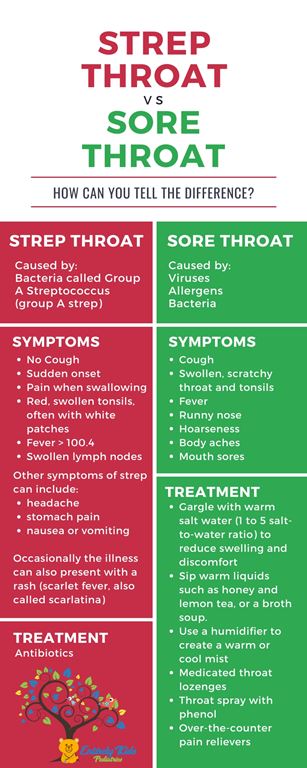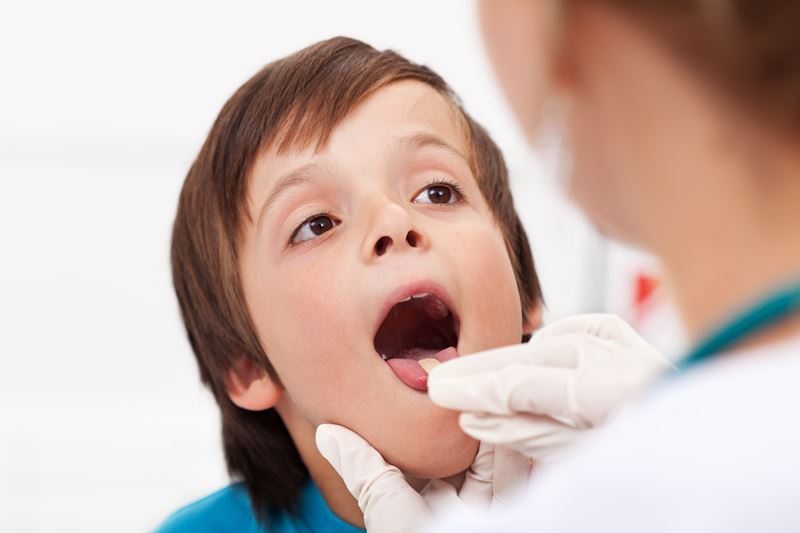Strep Throat vs Sore Throat: How Can You Tell the Difference?
STREP THROAT
The boogeyman of sickness for parents everywhere, strep throat is one of the most unpleasant illnesses your child can experience. Just the words, “My throat hurts,” from your child can strike terror in the calmest parent. However, not all sore throat illnesses are strep throat. How can you tell the difference?
Strep Throat
Strep throat is an infection in the throat and tonsils caused by bacteria called group A Streptococcus (group A strep). While a common illness for children, strep throat is not as common in adults. It is most common in children 5 through 15 years old. It is rare in children younger than 3 years old.
Symptoms of Strep Throat
In general, strep throat is a mild infection, but it can be very painful. The most common symptoms of strep throat include:
• Sudden onset of a sore throat
• Pain when swallowing
• Fever
• Red and swollen tonsils, often displaying white patches or streaks of pus
• Swollen lymph nodes in the front of the neck
• Tiny, red spots (petechiae) on the roof of the mouth (the soft or hard palate)
Other symptoms of strep can include headache, stomach pain, nausea, or vomiting. Occasionally the illness can also present with a rash known as scarlet fever (also called scarlatina).
How Strep Throat is Spread
Group A Streptococcus is found in the nose and throat. It is easily spread to other people by coughing or sneezing, which creates small respiratory droplets that contain the bacteria. The incubation period of group A strep is approximately 2 to 5 days.
People can be infected with the bacteria if they:
• Breathe in infected droplets
• Touch something with infected droplets on it and then touch their mouth or nose
• Touch sores on the skin caused by group A strep (impetigo)
• Share drinks or utensils with an infected person
While uncommon, it is also possible for Group A Streptococcus to be spread via foodborne transmission.
Close contact with another person with strep throat is the most common risk factor, but it is important to note that not all of those infected display symptoms of illness. As a result, schools and daycares are often unknowing facilitators of the illness’ transmission. Parents of school-age children and adults who work in these environments are at more risk of contracting this infection than other adults. Infectious illnesses are most likely to spread wherever large groups of people gather together.
Strep Throat Treatment
Strep throat is treated with a course of antibiotics. For children who are not allergic, penicillin or amoxicillin are recommended, but your pediatrician may use other antibiotics to treat those who are.
Doctors and clinicians can use a rapid antigen detection test (RADT) or throat culture to confirm group A strep infection. A throat culture is considered the gold standard diagnostic test, as RADTs have high specificity for group A strep but can have varying accuracy when compared to a throat culture. A person who tests positive for strep throat, but has no symptoms is referred to as a “carrier.” A carrier usually does not need antibiotics and are less likely to spread the bacteria to others. If a carrier gets a sore throat illness caused by a virus, the rapid strep test can be positive. In this situation, it can be hard to know what is causing the sore throat. If your child continues to get repeated sore throats after taking antibiotics, they may be a strep carrier with a viral throat infection.

Other Sore Throat Illnesses
A sore throat can be caused by pollen, dust, and food allergens. It can also be the result of a bacterial infection. Viruses are the most common cause of sore throats. Viral symptoms include:
• Swollen, scratchy throat and tonsils
• Cough
• Rhinorrhea (runny nose)
• Congestion
• Hoarseness
• Oral ulcers
• Conjunctivitis
• Moderate fever
• Earache
• Moderate rash
• Lump on the neck (caused by swollen glands)
• Difficulty breathing
Flu and viral infections do not respond to antibiotics. Medicines that ease symptoms may be prescribed or over-the-counter versions recommended, as home treatment is usually all that is needed for patients suffering with a viral infection.
Other recommendations often include:
• Gargle with warm salt water (1 to 5 ratio of salt to water) to help reduce swelling and relieve discomfort
• Warm liquids, such as honey & lemon tea or a broth soup
• Warm or cool mist using a humidifier
• Medicated throat lozenges
• Throat sprays containing phenol
At Entirely Kids Pediatrics, we specialize in providing top-notch pediatric care to ensure your child’s health is always our priority. Whether it’s a routine check-up or addressing concerns like sore throat, our team is here to help.
If your child’s illness returns or lasts for longer than a week, or if your child seems dehydrated, you should contact our office and make another appointment with Dr. Leung as soon as possible.
Experiencing sudden symptoms of strep throat? At Entirely Kids Pediatrics, we offer Same-Day Sick Visits to address urgent health concerns promptly, ensuring your child gets the care they need without delay.
